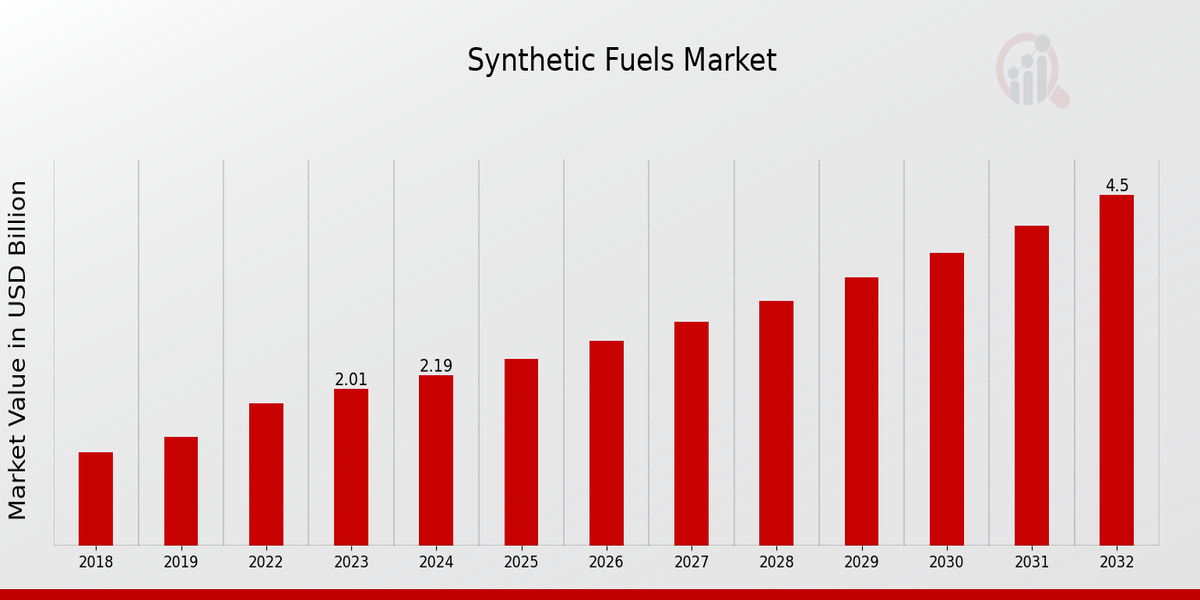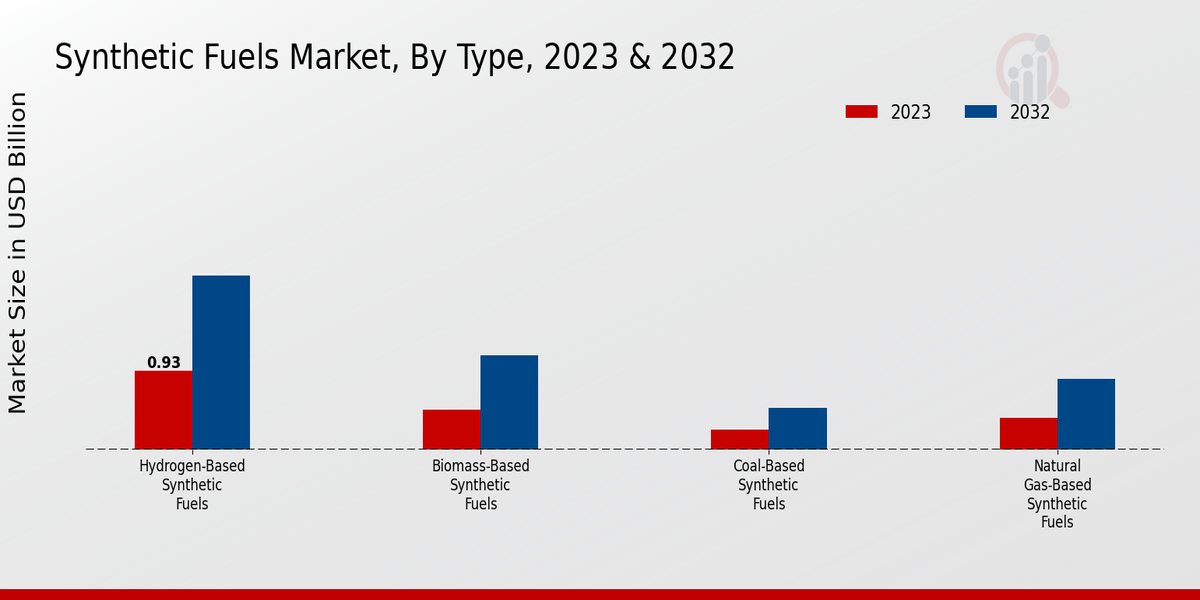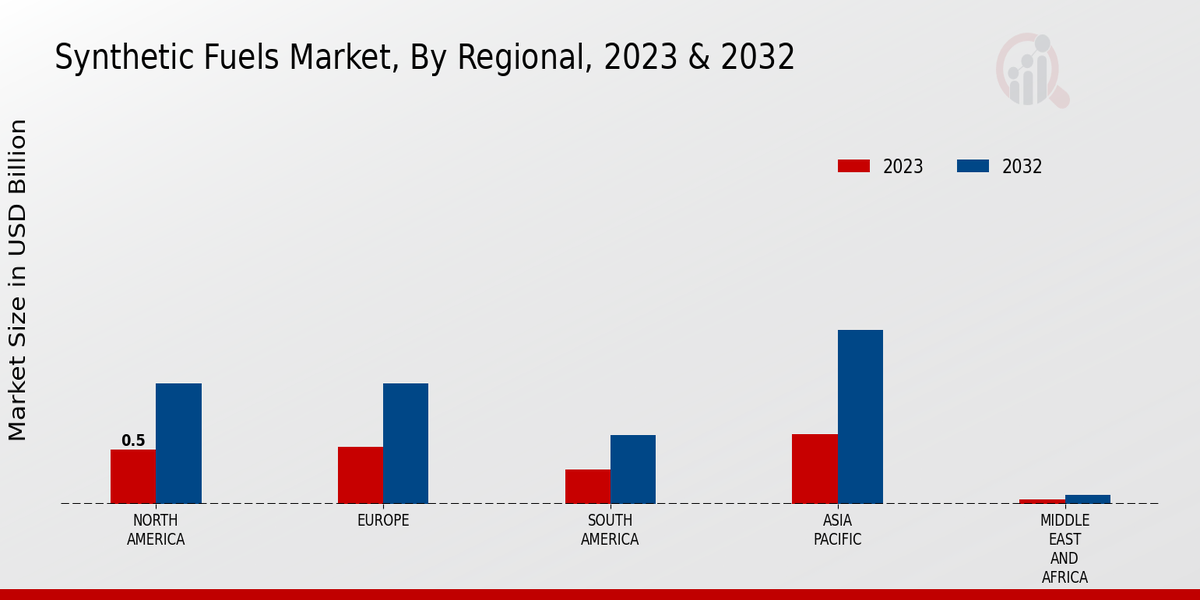Synthetic Fuels Market Overview
As per MRFR analysis, the Synthetic Fuels Market Size was estimated at 1.83 (USD Billion) in 2024. The Synthetic Fuels Market Industry is expected to grow from 2.01(USD Billion) in 2025 to 4.5 (USD Billion) by 2034. The Synthetic Fuels Market CAGR (growth rate) is expected to be around 9.4% during the forecast period (2025 - 2034).
Key Synthetic Fuels Market Trends Highlighted
The synthetic fuels market is projected to grow significantly due to rising environmental concerns, increasing demand for sustainable energy sources, and government initiatives to reduce carbon emissions. Factors such as increasing dental problems, a change in lifestyle, and improved economic conditions are expected to facilitate the growth of the synthetic fuels market.
The market is gaining popularity due to the sustainability practices of companies that include biodegradable plastics, clean energy initiatives, and integrated R&D labs. Bi-branded prospects incorporate production of synthetic fuels from biomass, as well as construction of flexible liquid hydrogen plants. Expansion of feedstock with bio based and carbon dioxide sources and AI and machine learning development cache usage are trendy. Further demand will be driven by the rising focus on R&D spending leading to more new developments with lower costs.
 Source: Primary Research, Secondary Research, MRFR Database and Analyst Review
Source: Primary Research, Secondary Research, MRFR Database and Analyst Review
Synthetic Fuels Market Drivers
Rising Demand for Clean and Sustainable Fuels
The increasing realization of the environmental ramifications of using conventional fossil fuels by vehicles is tremendously driving the demand for alternative fuels that are not only environmentally friendly but also sustainable. Synthetic fuels can be derived from biomass, natural gas, or coal can lower greenhouse gas emissions and enhance air quality. Additionally, they can promote energy security over the coming years. Thus, it is clear that the increasing demand for environment-friendly and sustainable sources of fuel is one of the prominent factors expected to propel the synthetic fuels market in the coming years.
Government Policies and Regulations
Government policies and regulations are playing a significant role in shaping the Synthetic Fuels Market Industry. Many countries have implemented policies to promote the adoption of renewable energy sources, including synthetic fuels. These policies often provide financial incentives, such as tax breaks or subsidies, to encourage investment in synthetic fuel production and consumption. Additionally, governments are implementing regulations to reduce greenhouse gas emissions, which is creating a favorable environment for the adoption of synthetic fuels.
Technological Advancements
Technological advancements are continuously improving the efficiency and cost-effectiveness of synthetic fuel production. Research and development efforts are focused on developing new catalysts, optimizing production processes, and reducing the cost of raw materials. These advancements are making synthetic fuels more competitive with traditional fossil fuels, which is expected to drive growth in the Synthetic Fuels Market Industry.
Synthetic Fuels Market Segment Insights
Synthetic Fuels Market Type Insights
The Synthetic Fuels Market is segmented by Type into Hydrogen-Based Synthetic Fuels, Biomass-Based Synthetic Fuels, Coal-Based Synthetic Fuels, and Natural Gas-Based Synthetic Fuels. Among these, Hydrogen-Based Synthetic Fuels held the largest market share in 2023 and is projected to be the most dominant segment throughout the forecast period. The growth of the segment is attributed to the rising demand for clean and sustainable sources of energy. These synthetic fuels are derived from hydrogen and carbon dioxide.
The hydrogen-based alternative has several advantages counter the conventional fossil fuels, including eco-friendliness, little or no emissions, production that can be shunted to specific sites irrespective of the location of the energy source, and the ability to enhance the efficiency of power plants. All of these factors cumulatively drive the sales of the Hydrogen-Based Synthetic Fuels segment. Biomass-Based Synthetic Fuels are also expected to experience significant growth over the next years. These fuels are manufactured from biomass, which consists of materials derived from plants, wood, and agricultural waste. The supply is considered sustainable and non-exhaustive.
The derivative can be used for various applications, including heating, transportation, and to generate power. The level of utilization can differ according to the demand for the particular type of energy produced in a specific area. Coal-Based Synthetic Fuels and Natural Gas-Based Synthetic Fuels are expected to hold a smaller share of the market. The former is derived from coal and is mostly utilized in various industrial applications. Finally, the latter is produced using natural gas. It is allocated to applications on various platforms, including transportation, heat, and to generate power.
Overall, the Synthetic Fuels Market is expected to grow, and reach USD 4.5 billion by 2032.
 Source: Primary Research, Secondary Research, MRFR Database and Analyst Review
Source: Primary Research, Secondary Research, MRFR Database and Analyst Review
Synthetic Fuels Market Production Process Insights
The Synthetic Fuels Market is segmented by production process into Fischer-Tropsch Process, Methanol-to-Gasoline Process, Biomass Gasification Process, and Coal Liquefaction Process. Among these, the Fischer-Tropsch Process segment held the largest market share in 2023 and is projected to continue its dominance throughout the forecast period. The Fischer-Tropsch Process is a well-established technology for converting syngas into liquid fuels, and it is widely used in commercial-scale synthetic fuel production plants. The Methanol-to-Gasoline Process segment is expected to witness significant growth over the forecast period, due to the increasing demand for methanol as a transportation fuel.
The Biomass Gasification Process and Coal Liquefaction Process segments are also expected to contribute to the growth of the Synthetic Fuels Market, as these processes offer environmentally friendly and cost-effective alternatives to conventional fossil fuel production methods.
Synthetic Fuels Market Application Insights
The Synthetic Fuels Market is segmented into Transportation, Power Generation, and Industrial Processes. The Transportation segment is expected to hold the largest market share in 2023 and is projected to grow at a CAGR of 9.4% from 2023 to 2032. The growth of this segment is attributed to the increasing demand for synthetic fuels in the aviation and shipping industries. The Power Generation segment is expected to witness significant growth over the forecast period due to the rising demand for clean and renewable energy sources.
The Industrial Processes segment is expected to grow steadily over the forecast period due to the increasing use of synthetic fuels in various industrial applications.
Synthetic Fuels Market End-User Industry Insights
The Synthetic Fuels Market is segmented into various end-user industries, including automotive, aviation, marine, and manufacturing. The automotive industry is expected to dominate the market in 2023, accounting for a significant share of the Synthetic Fuels Market revenue. The growing demand for low-carbon fuels in the transportation sector is driving the market growth in this segment. The aviation industry is also expected to witness substantial growth, as synthetic fuels offer a sustainable alternative to traditional jet fuels. The marine industry is expected to show steady growth, driven by the increasing adoption of synthetic fuels in ships and other marine vessels.
The manufacturing industry is expected to have a moderate growth rate, as synthetic fuels are used as feedstock for various industrial processes. Overall, the segmentation of the Synthetic Fuels Market by end-user industry provides valuable insights into the diverse applications and market dynamics of synthetic fuels across different sectors.
Synthetic Fuels Market Regional Insights
The Synthetic Fuels Market market is segmented into North America, Europe, APAC, South America, and MEA. Among these regions, North America and Europe are expected to hold a significant market share in the coming years. The growth in these regions can be attributed to the increasing demand for synthetic fuels from various industries, such as transportation and power generation. Additionally, government regulations promoting the use of renewable energy sources are also driving the growth of the synthetic fuels market in these regions.
The APAC region is also expected to witness significant growth in the coming years, owing to the increasing demand for synthetic fuels from the transportation and industrial sectors. The South America and MEA regions are also expected to contribute to the growth of the synthetic fuels market, albeit at a slower pace compared to the other regions.
 Source: Primary Research, Secondary Research, MRFR Database and Analyst Review
Source: Primary Research, Secondary Research, MRFR Database and Analyst Review
Synthetic Fuels Market Key Players and Competitive Insights:
Major players in the Synthetic Fuels Market industry are adopting various strategies to gain competitive advantage. Leading Synthetic Fuels Market players are focusing on expanding their product portfolio by introducing new and innovative products. They are also investing in research and development to improve the efficiency and performance of their products. For instance, in 2023, Velocys, a leading provider of sustainable fuels technology, announced the launch of its second-generation Fischer-Tropsch (FT) technology. This new technology offers improved efficiency, and reduced emissions compared to traditional FT technologies. One of the leading players in the Synthetic Fuels Market is Honeywell.
Honeywell is a technology company that provides a range of products and services for the aerospace, building, and process control industries. The company's synthetic fuels include the production of renewable fuels, such as biofuels and synthetic natural gas. Honeywell has a strong track record of innovation in the synthetic fuels industry and has developed a number of proprietary technologies. The company is also a member of the Renewable Fuels Association and the American Council on Renewable Energy. A key competitor in the Synthetic Fuels Market is Neste.
Neste is a Finnish company that is one of the world's leading producers of renewable fuels. The company's synthetic fuels business includes the production of renewable diesel and sustainable aviation fuel. Neste has a strong focus on sustainability and has set a goal of reducing its greenhouse gas emissions by 50% by 2030. The company is also a member of the World Economic Forum's Agenda Council on Advanced Manufacturing.
Key Companies in the Synthetic Fuels Market Include:
Synthetic Fuels Market Industry Developments
The synthetic fuels market is projected to reach USD 4.5 billion by 2032, exhibiting a CAGR of 9.4% from 2024 to 2032. Rising concerns over climate change and the depletion of fossil fuels are driving the demand for sustainable alternatives, making synthetic fuels a promising solution. Recent advancements in technology, such as the development of efficient catalysts and improved production processes, have made synthetic fuels more cost-effective and environmentally friendly. Additionally, government incentives and regulations promoting the adoption of renewable energy sources are further bolstering the growth of the synthetic fuels market.
Key players in the industry are actively investing in research and development to enhance efficiency and reduce the costs of synthetic fuel production. Strategic partnerships and collaborations are also prevalent, as companies seek to gain a competitive edge in this rapidly evolving market.
Synthetic Fuels Market Segmentation Insights
Synthetic Fuels Market Type Outlook
Synthetic Fuels Market Production Process Outlook
Synthetic Fuels Market Application Outlook
-
-
Transportation
-
Power Generation
Synthetic Fuels Market End-User Industry Outlook
Synthetic Fuels Market Regional Outlook
| Report Attribute/Metric |
Details |
| Market Size 2024 |
2.40 (USD Billion) |
| Market Size 2025 |
2.62 (USD Billion) |
| Market Size 2034 |
5.90 (USD Billion) |
| Compound Annual Growth Rate (CAGR) |
9.4% (2025 - 2034) |
| Report Coverage |
Revenue Forecast, Competitive Landscape, Growth Factors, and Trends |
| Base Year |
2024 |
| Market Forecast Period |
2025 - 2034 |
| Historical Data |
2020 - 2024 |
| Market Forecast Units |
USD Billion |
| Key Companies Profiled |
Chevron, Shell, Eni, HollyFrontier, Neste, Marathon Petroleum, PBF Energy, ExxonMobil, TotalEnergies, Valero Energy, Repsol, Koch Industries, Phillips 66, Velocys, BP |
| Segments Covered |
Type, Production Process, Application, End-User Industry, Regional |
| Key Market Opportunities |
Growing transportation sector high oil dependence government incentives technological advancements rising environmental concerns |
| Key Market Dynamics |
Growing demand for sustainable aviation fuels Government initiatives supporting decarbonization Rising crude oil prices Technological advancements in synthetic fuel production Increasing adoption of synthetic fuels in heavy industries |
| Countries Covered |
North America, Europe, APAC, South America, MEA |
Frequently Asked Questions (FAQ):
The synthetic fuels market is projected to reach USD 5.90 billion by 2034, exhibiting a CAGR of 9.4% during the forecast period (2025-2034).
North America and Europe are expected to dominate the market throughout the forecast period due to the increasing adoption of stringent emission regulations and government initiatives promoting the use of sustainable fuels.
Synthetic fuels are primarily used in transportation applications, including road, aviation, and marine sectors. The growing demand for sustainable and low-carbon transportation fuels is a key factor driving market growth.
Some of the prominent players in the synthetic fuels market include Neste, Velocys, Haldor Topsoe, and Sasol. These companies are actively involved in research, development, and production of synthetic fuels to meet the growing demand for sustainable energy solutions.
The high production costs and limited availability of feedstocks for synthetic fuel production are some of the challenges faced by the industry. Additionally, the scalability of synthetic fuel production and the development of efficient distribution networks remain important areas of focus for market growth.
The increasing demand for low-carbon fuels, coupled with government support and incentives for sustainable energy solutions, presents significant growth opportunities for the synthetic fuels market. Technological advancements and innovations in synthetic fuel production methods are also expected to drive market expansion.
Government regulations aimed at reducing greenhouse gas emissions and promoting the use of renewable energy sources have a positive impact on the growth of the synthetic fuels market. Stringent emission standards and policies supporting the adoption of sustainable fuels create a favorable environment for market development.
The synthetic fuels market is anticipated to witness steady growth in the coming years. Technological advancements, increasing investments in research and development, and the growing adoption of synthetic fuels in various sectors are expected to contribute to the market's expansion.
The integration of renewable energy sources, such as solar and wind power, into synthetic fuel production is a key trend shaping the market. Additionally, advancements in carbon capture and utilization technologies are expected to play a significant role in the sustainable development of the industry.
The synthetic fuels market is projected to reach approximately USD 2.62 billion by 2025, exhibiting a CAGR of 9.4% from 2025 to 2034.






 Source: Primary Research, Secondary Research, MRFR Database and Analyst Review
Source: Primary Research, Secondary Research, MRFR Database and Analyst Review Source: Primary Research, Secondary Research, MRFR Database and Analyst Review
Source: Primary Research, Secondary Research, MRFR Database and Analyst Review Source: Primary Research, Secondary Research, MRFR Database and Analyst Review
Source: Primary Research, Secondary Research, MRFR Database and Analyst Review







